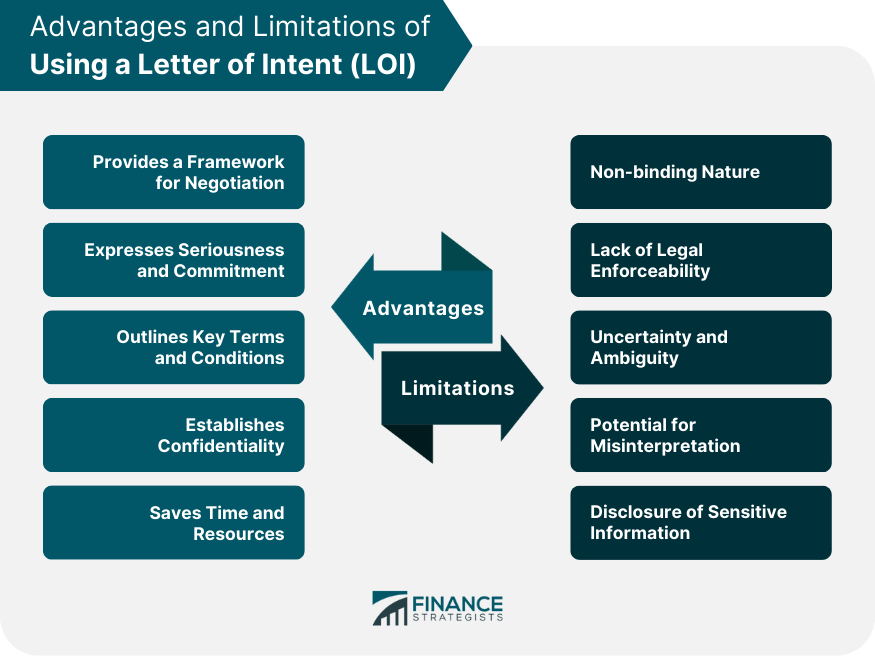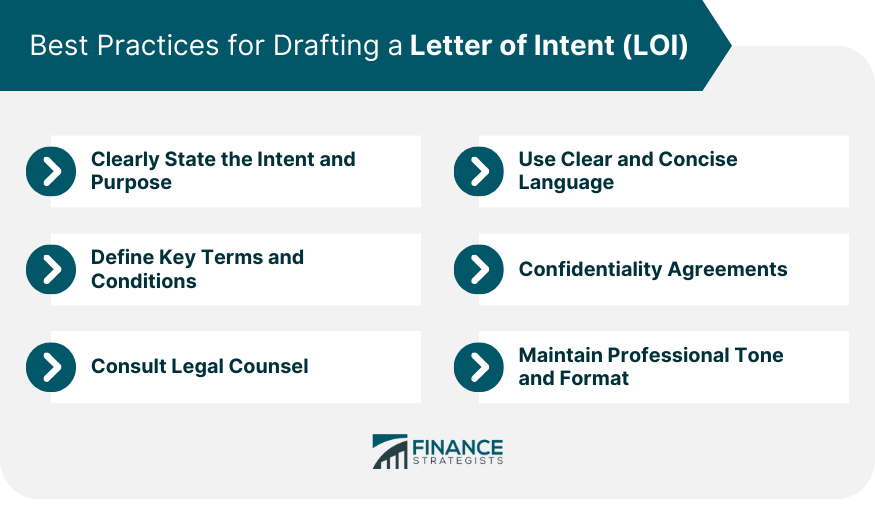A Letter of Intent, or LOI, is a document in which one party declares their intent to do business with another. These letters are preliminary to any formal deals or terms, and are designed to be general and non-legally binding. Often used in complex transactions or arrangements, an LOI functions as a road map, providing clarity to involved parties about the deal's key aspects. LOIs are similar to term sheets, except that an LOI is presented in letter format and term sheets in a list format. An LOI may have different purposes depending on the business: Most often they are used as a written way to lay out some of the most basic, early terms of a formal financial deal, particularly to make apparent what details of the deal need to be negotiated further. An LOI may also be used to signal the initiation of a business deal such as a merger or acquisition. Its most important function is to define the specifics of a complex transaction before a formal contract is drafted, thereby avoiding misunderstandings and disagreements later. Moreover, an LOI is invaluable in expressing serious intent to pursue an agreement, indicating goodwill and trust between parties involved. An effective Letter of Intent (LOI) is made up of several key elements that collectively form a comprehensive outline of a proposed agreement. These elements typically include details such as the parties involved, the main terms and conditions of the agreement, the timeline for finalizing the contract, and any binding clauses like confidentiality agreements or exclusivity clauses. While the exact components can vary depending on the nature of the deal, a well-crafted LOI should always be clear, concise, and detailed. In business acquisition scenarios, an LOI outlines the primary terms and conditions of a potential purchase. It generally includes details like the purchase price, closing date, due diligence process, and any binding provisions. An acquisition LOI is a pivotal document that helps establish a clear path forward for both the buyer and the seller. A partnership LOI, utilized in scenarios where two or more entities plan to collaborate, outlines the potential terms of the partnership. It is used as a tool for negotiating and refining the specifics of the arrangement. This LOI includes information about the roles and responsibilities of each partner, revenue sharing, dispute resolution, and other pertinent details. An employment LOI is typically used to confirm the intent of an employer to hire a prospective employee. This letter may include elements such as job description, salary, benefits, and the proposed start date. Notably, an employment LOI can facilitate the transition from recruitment to employment. In the realm of real estate, an LOI is employed to stipulate the basic terms of a transaction, such as the purchase price, closing date, and financing details. Used in both residential and commercial real estate transactions, it serves as a precursor to a formal sales contract and allows parties to negotiate the specifics of the deal. In the realm of venture capital or grants, a funding LOI illustrates an investor's or grantor's intent to invest or provide funds to a business or project. It typically includes details about the amount to be invested, the equity stake or grant conditions, and any specific terms or conditions associated with the investment or grant. A licensing LOI is used when one party intends to license intellectual property rights from another party. It usually outlines the main terms of the proposed licensing agreement, including the scope of the license, payment terms, and duration of the agreement. One of the major benefits of using an LOI is that it provides a solid framework for negotiation. By delineating the major terms and conditions at the outset, parties have a reference point for discussions. This approach mitigates confusion, and paves the way for smoother, more productive negotiations. An LOI also serves to signal the commitment and seriousness of the parties involved in a transaction. This communication of intent can be vital in establishing trust, particularly in complex or high-stakes transactions where the goodwill of both parties is essential. Another key advantage of an LOI is that it outlines the main terms and conditions of a proposed agreement, which can help prevent misunderstandings and disagreements down the line. This overview ensures all parties have a clear understanding of what is expected and what has been agreed upon. LOIs often include confidentiality clauses, serving to protect sensitive information disclosed during negotiations. This provision can be critical for businesses or individuals concerned about the potential exposure of proprietary information. By providing an initial outline of the proposed agreement, an LOI saves significant time and resources that might otherwise be spent in protracted negotiations. With a clear path forward, parties can focus on ironing out the finer details of the agreement. Despite its advantages, an LOI also presents certain limitations and risks. Understanding these is key to effectively utilizing this tool in any negotiation process. The non-binding nature of an LOI can be a limitation. While an LOI communicates serious intent, it does not compel either party to finalize the deal. In other words, either party may back out of the agreement after the LOI is signed. As a general rule, LOIs lack legal enforceability. If a party deviates from the outlined terms or decides to back out of the agreement, the other party may not have legal recourse. This can potentially lead to financial losses or wasted resources. If not drafted clearly, an LOI can create uncertainty and ambiguity. This can occur when the terms are vague, or when the LOI doesn't adequately address all aspects of the proposed agreement. Another risk associated with LOIs is the potential for misinterpretation. If parties have different interpretations of the terms outlined in the LOI, it can lead to disputes and derail the negotiation process. Though an LOI often includes a confidentiality clause, there's always a risk associated with the disclosure of sensitive information. If confidential data is improperly handled or leaked, it can potentially damage a business or an individual's interests. To extract maximum value from an LOI and avoid the pitfalls, it is important to adhere to certain best practices while drafting it. While drafting an LOI, it's essential to state the intent and purpose clearly. Ambiguity can lead to misunderstandings, and the purpose of an LOI is to avoid such complications. The language used in an LOI should be clear and concise. This not only ensures that the document is easy to understand, but it also minimizes the possibility of misinterpretation. The key terms and conditions of the proposed agreement should be clearly defined in the LOI. This includes all important elements of the deal, from financial arrangements to confidentiality agreements. Given the potential legal implications of an LOI, it's crucial to consult legal counsel before drafting or signing one. A lawyer can help ensure that the LOI is drafted correctly and that it adequately protects the interests of the parties involved. Maintaining a professional tone and format is a must while drafting an LOI. This helps communicate the seriousness of the intent and ensures that the document is perceived as credible and authoritative. Outside of business deals, it is very common for other institutions or individuals to use letters of intent to make a written declaration of some terms of an agreement. For example: College graduates applying for graduate school are often required to write a letter of intent detailing the terms of their study. Parents may also write a letter of intent for their children, often in addition to a legally binding document like a will, describing what they wish to happen in the event of their deaths. The Letter of Intent serves to outline preliminary agreements between parties before a formal contract comes into play. It comes in multiple forms, each specific to a certain context, and provides a wealth of benefits, including a framework for negotiation, confidentiality, and resource conservation. However, it is not without its drawbacks, which include its non-binding nature, lack of legal enforceability, and the potential for misinterpretation. As such, observing best practices, such as using clear language, defining key terms, and consulting legal counsel, is crucial to maximizing the effectiveness of an LOI. Whether it's a business acquisition, a partnership, an employment offer, a real estate transaction, a funding agreement, or a licensing deal, a well-drafted LOI can pave the way for a smooth negotiation process and a successful final agreement. While it's not without its potential pitfalls, these can be mitigated with due care, making an LOI an invaluable tool in the world of business and beyond.What Is a Letter of Intent?
The Purposes of a Letter of Intent
Key Elements of a Letter of Intent (LOI)
Types of Letter of Intent (LOI)
Business Acquisition
Partnership
Employment
Real Estate
Funding
Licensing
Advantages of Using a Letter of Intent (LOI)
Provides a Framework for Negotiation
Expresses Seriousness and Commitment
Outlines Key Terms and Conditions
Establishes Confidentiality
Saves Time and Resources
Limitations and Risks of a Letter of Intent (LOI)
Non-binding Nature
Lack of Legal Enforceability
Uncertainty and Ambiguity
Potential for Misinterpretation
Disclosure of Sensitive Information

Best Practices for Drafting a Letter of Intent (LOI)
Clearly State the Intent and Purpose
Use Clear and Concise Language
Define Key Terms and Conditions
Consult Legal Counsel
Maintain Professional Tone and Format

LOI Examples
Conclusion
Letter of Intent (LOI) FAQs
LOI is an acronym for a Letter of Intent.
A Letter of Intent, or LOI, is a document in which one party declares their intent to do business with another.
Most often LOI's are used as a written way to lay out some of the most basic, early terms of a formal financial deal, particularly to make apparent what details of the deal need to be negotiated further.
LOI's are sometimes used to signal the initiation of a business deal such as a merger or acquisition.
Yes, one example would a graduate school applicant who is required to write a letter of intent detailing their proposed study. Another would be parents who write a letter of intent for their children, often in addition to a legally binding document like a will, describing what they wish to happen in the event of their deaths.
True Tamplin is a published author, public speaker, CEO of UpDigital, and founder of Finance Strategists.
True is a Certified Educator in Personal Finance (CEPF®), author of The Handy Financial Ratios Guide, a member of the Society for Advancing Business Editing and Writing, contributes to his financial education site, Finance Strategists, and has spoken to various financial communities such as the CFA Institute, as well as university students like his Alma mater, Biola University, where he received a bachelor of science in business and data analytics.
To learn more about True, visit his personal website or view his author profiles on Amazon, Nasdaq and Forbes.















